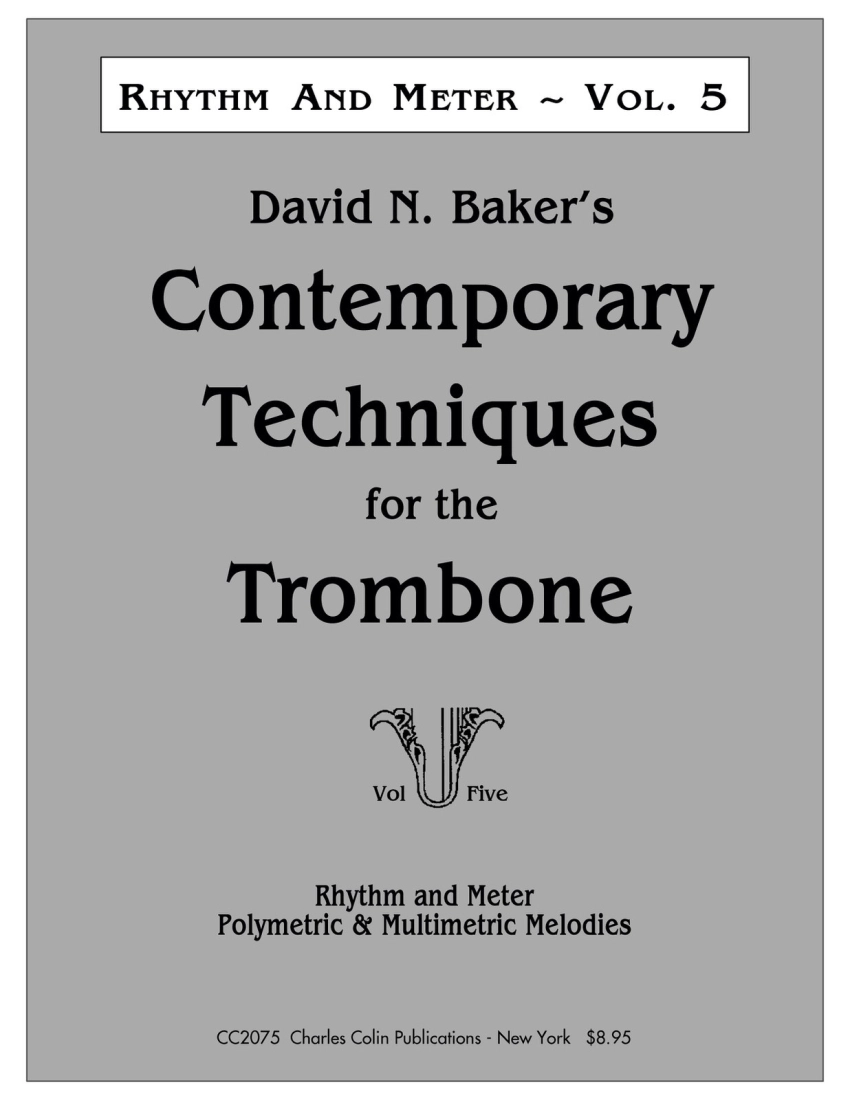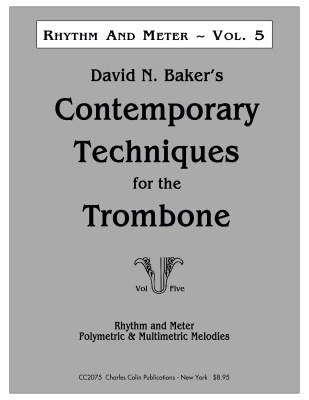Opens in a new window
Charles Colin Publications Contemporary Techniques for the Trombone, Volume 5: Rhythm and Meter - Baker - Trombone - Book

- Composer/Author: BAKER, DAVID N.
- Instrumentation: TROMBONE
- Model # CC2075
Format: Book
Instrumentation: Trombone
David N. Baker's Contemporary Techniques for the Trombone is a comprehensive 6 volume series covering the skills, techniques, and basic tools of the aspiring jazz trombonist. Each volume covers a specific topic.
Volume 1 -- Foundation Exercises for the Jazz Player -- Vibrato and other Special Effects Tod-ul Tongue
Volume 2 -- Against the Grain Playing -- Scales and Chords
Volume 3 -- The II V 7 Progression -- Turnbacks & Cycles
Volume 4 -- A Method for Gaining Facility with the Various Scales -- Scales, Multiphonics & Polytonality
Volume 5 -- Rhythm and Meter -- Polymetric & Multimetric Melodies -- Fourths
Volume 6 -- Exercises Based on the 12 Tone Row -- Use of Dramatic Devices -- Micro Tones
From the Foreword: "Never before in the history of music have there been so many divergent schools of musical thought co-existing and enjoying some measure of popularity. Since the turn of the century the language of music has been time and time again torn apart, restructured, added to, subtracted from, purged, examined and re-examined.
The 1900's, have seen the birth and/or bringing to fruition of such myriad musical concepts as pantonality, pandiatonicism, panchromaticism, bitonality, polytonality, serialization techniques, Klangfarben melodien, micro and macro tonal techniques, improvisation (jazz and otherwise), chance music, set systems, computerization, electronic music, sound mass (noise factors, etc.), happenings, anti-art, multi media, polymetric, multimetric and non-metric writing, metric modulation, ad infinitum.
Add to these concepts: new scales; old scales used in non-traditional ways; non-traditional uses of rhythm; new instrumental techniques, such as, circular breathing, multiphonics, expanded ranges, new timbre concepts, increased virtuosity; new concepts about the ways in which the basic sound of traditional instruments can be altered; new instruments -- trombonium, mellophonium, electric piano, electric bass, etc. -- ad hoc instruments; and it should be obvious that a staggering array of new possibilities with concomitant problems exist for any performer preparing to deal with music of the twentieth century and beyond. Most applied music teachers in our conservatories, schools of music, colleges, high schools and on the private level are ill-prepared to deal, even perfunctorily, with many of the aforementioned concepts.
Too often, if an awareness even exists that anything has happened in music since 1900, this awareness is accompanied by apathy, ill-disguised tolerance or open hostility toward the music and the musician who plays it."
For the sympathetic and conscientious teacher who would prepare his students to function in all musical situations, there is another problem: the inexcusable dearth of materials aimed at preparing a student for performance of any music more recent than Stravinsky circa 1912.
This book series addresses itself to the teacher, student, amateur and professional trombonist who would survive in the world of twentieth century music.
Q & A
There are currently no questions for this product.
Reviews
There are currently no reviews for this product. Be the first to write one!




